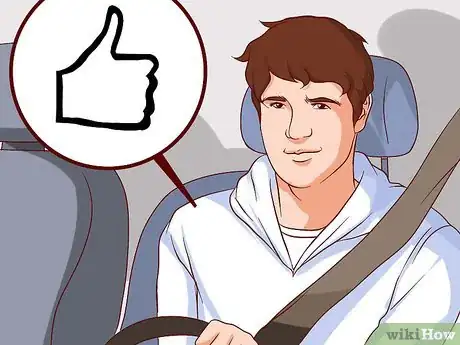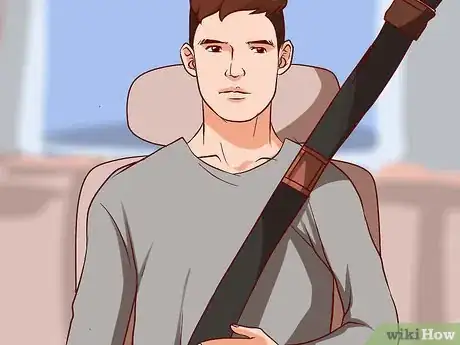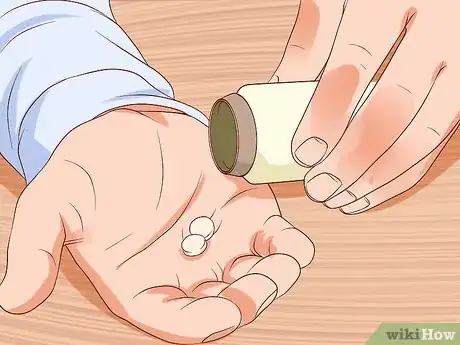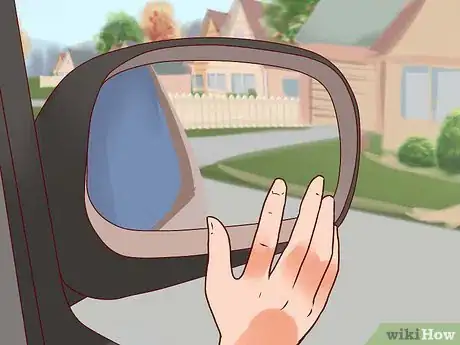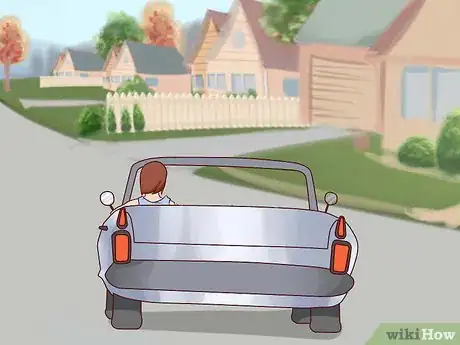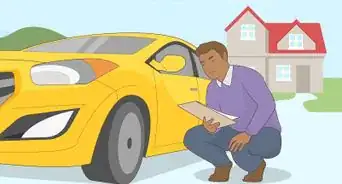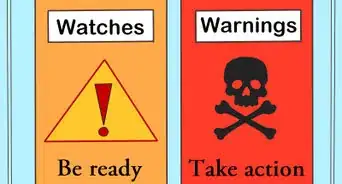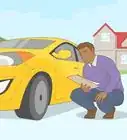This article was co-authored by Trudi Griffin, LPC, MS. Trudi Griffin is a Licensed Professional Counselor in Wisconsin specializing in Addictions and Mental Health. She provides therapy to people who struggle with addictions, mental health, and trauma in community health settings and private practice. She received her MS in Clinical Mental Health Counseling from Marquette University in 2011.
There are 12 references cited in this article, which can be found at the bottom of the page.
This article has been viewed 54,837 times.
A fear of driving may cause you to feel a bit anxious before you have to drive somewhere, while a phobia of driving may prevent you from driving at all.[1] Although a fear of driving may not prevent you from driving, it can make it stressful to get behind the wheel of a car. And if you have a driving phobia, then this can be even more stressful and it can also prevent you from doing things like driving to work, going to visit friends, or running errands. Whatever the reason behind your fear of driving, it is possible to get past it and finally sit behind the wheel with confidence.
Steps
Addressing Your Fear
-
1Recognize the difference between a fear and a phobia. Your fear of driving may be a phobia if it is so severe that it causes debilitating symptoms.[2] If you are just a bit frightened by the idea or act of driving, then it is probably not a phobia. For example, a fear of driving might cause you to feel a bit nervous before you start your morning commute, while a phobia might cause you to avoid driving altogether by taking public transportation or riding your bike to work. Phobias may cause emotional and physical symptoms such as:
- feeling dizzy
- sweating
- having chest pain
- having difficulty breathing
- trembling or shaking
- having a racing pulse
- feeling anxious
- wanting to escape or run away
- feeling like you are going crazy or dying
- feeling powerless to control your fear[3]
-
2Acknowledge the source of your fear. The first step toward getting over your fear of driving is to try to pinpoint the reason you are afraid. Many people with this issue experienced a traumatic event at some point in their past that turned them off to the idea of piloting a car; for others, the fear arose gradually.[4] For still others, driving fear has a more indirect source. The following are examples of how some driving fears and phobias start:[5]
- You were in a serious car accident. This is a big reason some people don't like to drive, and it is especially likely to be problematic if it happened when you were a young, inexperienced driver (or as a child passenger).
- You had a negative experience when first learning to drive, such as being yelled at by an impatient teacher or being a victim of another driver's road rage.
- You become anxious or feel trapped during traffic jams.
- You found yourself driving in bad weather such as deep snow, icy roads, heavy rain or fog, or high winds. Whether or not such an event results in an accident, it can lead to fear of driving if it is a frightening experience.
- You are frightened by stories of traffic accidents. Sometimes just knowing what could happen is enough to generate heightened fear of driving.
- You are prone to anxiety attacks, which you fear having while driving and losing control as a result.
- Stress and anxiety in other aspects of your life has boiled over to affect your driving confidence.[6]
Advertisement -
3Consider therapy. Phobias, especially when deep-seated, can be difficult to overcome without assistance. If you cannot seem to overcome your driving phobia or if your phobia is impacting your quality of life, you should think about seeing a therapist. A therapist can help you to address the problem and take steps to overcome your driving phobia.[7]
- Even if you have a fear of driving and not a phobia, a therapist can help you to identify the source of your fear and become more comfortable with driving.
- Search online for therapists in your area and seek out those who specialize in anxiety disorders (the category under which most driving phobias fall).[8]
Preparing To Drive
-
1Learn to drive well. This means learning to drive defensively and not take on a passive role when behind the wheel. In addition to traditional driver's education (which is usually a mandatory part of getting a license in the first place), you can take defensive driving courses and skill-enhancement courses if need be.[9]
- Part of learning to be a good driver is knowing the rules of the road. Don't overwhelm yourself with details on traffic laws, but do become familiar with major laws and regulations (such as right-of-way guidelines).
- Taking informal lessons from a friend or family member who is a safe, experienced driver can go a long way toward building your confidence, and won't cost you anything but some time and effort.
- Before going out on the open road, go to an open lot (such as a store parking lot on days when the business is closed) with a friend and just get used to the feeling of being behind the wheel. Once you feel comfortable enough, practice starting and stopping, turning, and signaling.
- If even the idea of driving slowly in an empty parking lot frightens you, begin by just sitting in the driver's seat of your car with the engine off. Eventually, start the car; over time, the basic aspects of driving won't seem so scary.
-
2Practice self-calming techniques. These will work differently for different people, but could include things such as meditating, deep breathing, or praying. Find what works for you and do it on a daily basis. If you are naturally prone to panic attacks, this should be part of your daily routine already. If you have suffered a car accident, learning to keep calm when returning to driving is key to regaining self-confidence.[10]
- If you are in therapy for anxiety already, ask your therapist what you can do to calm yourself down in a situation where you are beginning to panic. Figuring out how to handle your anxiety before you go out on the road will be help your nerves immensely.[11]
- Keep in mind that it is rare for someone to have an accident while in the midst of a panic attack.[12]
-
3Know your vehicle's safety features. A certain degree of anxiety can be relieved by knowing as much as possible about how your car works. If you understand the operations of your vehicle's safety features and how they can protect you in the unlikely event of a crash, you may become less scared to drive.
- Know how to properly wear your seatbelt. The single biggest thing you can do to protect yourself from becoming injured during a crash is to wear your seatbelt. Seatbelts are most effective when worn low and tight across the lap and with the shoulder strap across your chest.[13]
- You may also want to consider a built-in emergency contact system, such as On Star. These systems make it easy for you to get help if you are in an accident and they will automatically send help if you can’t respond.[14]
- Most vehicle operator's manuals have sections devoted to safety features. Some even provide instructions on what to do in the event of an emergency. Alternatively, you can ask your insurance provider for this information.
-
4Get a good night's sleep. When planning to go out for a drive, make sure you are well-rested. Alertness and quick thinking are critical aspects of driving safely, and you will feel less anxious if you are not tired when you get behind the wheel. Do not rely upon caffeine or other artificial alertness aids to keep you awake.
- If you take medications that make you drowsy, do not drive while under their influence.
- Contrary to what you might expect, you could be more likely to have an anxiety attack if you try to drive while tired, as you might panic just knowing that you could fall asleep.
Going For a Drive
-
1Adjust your seat and mirrors. Before you even start the car, you should check that all your mirrors are aligned properly so that you can see to the sides and rear of your car from your forward-facing driving position. It is also important that your seat be adjusted so that you can comfortably reach the steering wheel and pedals.[15]
- Your side mirrors should give you a decent view of what is behind and slightly to the side of your car. While you will still have blind spots that can only be checked by turning your head, you will feel more comfortable if a quick glance at your mirrors shows you as much as possible.
- Avoid scooting your seat too far forward. If you are crowded into the steering wheel when driving, you could begin to feel trapped; additionally, the force of an airbag can injure a person if they are seated too close to it during deployment.
- Avoid reclining your seat too much. You don't want to create a gap between the shoulder strap of your seatbelt and your chest, as this will reduce the effectiveness of your seatbelt in the event of a collision.
-
2Expect problems. Some fear of driving comes from wanting a perfect driving experience without problems and being afraid that this won't happen. You need to get used to the idea that there will always be things to watch out for as you drive; however, if you're alert and expecting potential surprises, you'll be in a much better position to react appropriately.
- This does not mean you should anticipate the worst -- doing so will only make your anxiety worse and won't help you get past your fear. Rather, tell yourself that everything will work out fine, even if there's an issue.
-
3Plan out your trips. When you first begin driving, avoid becoming overwhelmed by having a clear route planned out for those initial drives. You should choose an area with which you are familiar and visualize your driving route ahead of time on a map or GPS device. This way, you won't be faced with deciding where to go once you're in the car.[16]
- Just driving around your block is a good way to start, unless your block is crowded or has lots of pedestrians or animals.
- Have a friend drive you out to a quiet, secluded location for your first few drives if this sounds less frightening to you. Just be sure to have the specific location planned out before you head out.
-
4Ease into driving gradually. Don't try to conquer Everest in a day. The important thing is that you end up driving eventually. Take small steps in the right direction by doing short trips near home with someone you trust. Gradually lengthen your driving expeditions and work up to trying some without a traveling companion present.[17] [18] [19]
- It is okay to go back a step if you feel you're progressing too quickly for comfort. In other words, if you went for a short drive with a friend but were terrified the whole time, you can temporarily go back to just sitting in the driver's seat with the engine running.
- If you are starting from the ground level (i.e., you were previously not driving at all), don't jump onto a busy freeway or city street without first becoming accustomed to mellow roads with little traffic.
Warnings
- Do not drive if you have been drinking or taking drugs, if you are really tired, or if your anxiety levels are unusually high. These things increase your chances of having a negative experience and can even cause an accident.⧼thumbs_response⧽
- Do not drive without a valid license or without proper registration and insurance for your vehicle; it is illegal to do so and could land you in hot water if something were to happen.⧼thumbs_response⧽
References
- ↑ http://www.helpguide.org/articles/anxiety/phobias-and-fears.htm
- ↑ http://www.webmd.com/anxiety-panic/guide/fear-factor-phobias
- ↑ http://www.helpguide.org/articles/anxiety/phobias-and-fears.htm
- ↑ http://www.anxietycare.org.uk/docs/driving.asp
- ↑ http://www.fearof.net/fear-of-driving-phobia-vehophobia/
- ↑ http://www.uncommonhelp.me/articles/are-you-scared-of-driving/
- ↑ http://www.helpguide.org/articles/anxiety/phobias-and-fears.htm
- ↑ https://www.psychologytoday.com/blog/fighting-fear/201207/driving-phobia-ideal-treatment
- ↑ http://driving-tests.org/beginner-drivers/get-over-fear-of-driving/
- ↑ http://www.anxietycare.org.uk/docs/driving.asp
- ↑ http://www.calmclinic.com/anxiety/types/driving
- ↑ https://www.psychologytoday.com/blog/fighting-fear/201207/driving-phobia-ideal-treatment
- ↑ https://www.nhtsa.gov/risky-driving/seat-belts
- ↑ https://www.onstar.com/us/en/services/emergency.html
- ↑ http://www.safercar.gov/
- ↑ http://smartdriving.co.uk/Driving/Attitude/Phobia/Driving_phobia.htm
- ↑ http://smartdriving.co.uk/Driving/Attitude/Phobia/Driving_phobia.htm
- ↑ http://www.anxietycare.org.uk/docs/driving.asp
- ↑ http://driving-tests.org/beginner-drivers/get-over-fear-of-driving/
About This Article
To overcome your fear of driving, one helpful step is to practice calming techniques every day like meditation, deep breathing, or praying, which help to distance you from anxious thoughts. Look into learning some defensive driving habits from an instructor or from a friend or family member so you feel more confident about avoiding dangers on the road. When you start driving, don’t be afraid to take things slow with short trips around your local area, so you can get comfortable behind the wheel before taking longer journeys. When you do take a longer trip, look over the route on a map or GPS before you go so you don’t need to stress about getting lost. For more tips from our Counselor co-author, including how to recognize the source of your fear of driving, read on!



